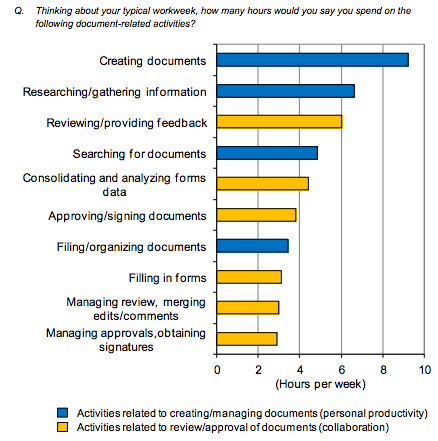Do you often feel like your whole work week went breezing by without a trace? Do you find yourself asking “How is it Friday already?!”, thinking of all the things you wanted to achieve that you couldn’t quite get done? Even if you are hard-working, organized and passionate about your work, we all have those little things that tend to subtly waste our time during the day, draining our productivity bit-by-bit.
Here at Brief, we believe those dastardly time wasters are our biggest enemy. If you could regain even a few minutes of lost productivity every day, think of how much more you could get done in a week, month or year’s time. In this post, we will outline a few sneaky villain time wasters that affect almost all professionals in today’s work environment. More importantly, we will show you ways you can fight back to avoid wasting time, accomplish more and even have more time for fun! So, what exactly are these time wasters, you ask?
1. Navigating irrelevant emails
Ahh, email. The underlying technology is almost as old as the internet itself, but research shows that as much as 95% of companies still use it as their main communication tool. Don’t get us wrong – the near-universality of email means that everyone has to use it to some extent. But email overload, left unmanaged for too long, can become one of our biggest time wasters.
The average office worker can spend as much as 33% of their time reading through and responding to emails. This is a truly staggering number – for many of us, every 3rd minute of work is spent staring at an inbox or typing an email. Of course, running a business requires constant communications between team members, management, clients and partners. But as we all know, not every email is actually worthy of your time and attention.
Almost every website, app or service we sign up to ends up clogging our inbox with a constant barrage of automated emails, making conversations with actual humans easy to miss. Our brains get overloaded with the electronic noise and we take the ping of a new email less seriously, as the unread number count on your inbox skyrockets by the minute. Workers are forced to either continuously hunt down that tiny ‘Unsubscribe’ link or just give up and watch their email count reach astronomical numbers. Sadly, it’s not only automated emails. The notorious ‘CC’ function is too often abused by workers. CCing a large group of people or hitting ‘Reply All’ on an email thread with multiple recipients can often be tempting. It provides an easy way to say “see, I told you!”, or just a visibility tactic to show colleagues just how hard working you are. This type of behavior results in even more time waste, and therefore must be actively combated by management and by your company culture.
The problem is that email has become the go-to place to make sure you have covered your back, CC’ing to ensure you have ticked the ‘I’ve informed them they need to do it’ box or a place where automated promotions and updates are fed into. Unless you spend a lot of time constructing an automated (and imperfect) system of rules, every email arrives at your inbox in the same way, with little in the way of prioritization or organization. Methods like ‘Inbox Zero’ promise an end to email overload, but require the rigor and determination of a stringent diet and fitness routine. You might think that since emails are often wordy, they would be more effective at conveying complex ideas or requests, but the data doesn’t support this. In fact, companies with fewer than 100 employees spend 17 hours each week clarifying communications from the previous week. The vast majority of this communication is done over email. How about that for a time waster?
Luckily, there is actually a better way of communicating, at the very least within your company. Workplace group chat apps like Brief are a faster, more organized and more efficient way of communicating. Instead of writing lengthy emails or reading through long, messy threads, each topic or team can have its own group chat, where all the relevant individuals can take part in the conversation. You don’t need to go hunting for particular emails. You don’t need to worry about forgetting to add someone as a recipient individually (or even worse, replying to a thread with a wrong recipient). Each person has full control of their own time and attention – if you want to tune out of a specific conversation, you can easily mute it to disable notifications (and go back to them when you have time to read through them). Group chat is a faster, better way to work, as long as you stick to some simple guidelines. We built Brief in a way that makes it super easy to communicate with people both inside and outside your organization – simply send a client or supplier an invite link to a particular Team Hub or Group Chat, and have them join the conversation in seconds.
2. Hunting down documents, files and attachments
Imagine this scenario: you need to update or work on a document. You roughly remember the file name. You know when you last worked on it. You even remember who sent it to you – but you simply can’t find it. Sound familiar? You’re not alone. Searching for files remains one of the biggest time wasters in the workplace.
Collaborating on documents is a massive pain point for the average American worker. When asked about their difficulties with documents, these were the responses:
- 49% struggled to locate documents
- 43% had difficulties sharing documents
- 33% were frustrated with document versioning
To give some additional flavor, A global survey of knowledge workers conducted by IDC reveals that the average workweek includes 4.5 hours of searching for documents. This means that even a small improvement that makes files easier to find can make a huge difference to a business’ overall productivity.
Modern cloud platforms like Google’s G Suite, Microsoft Office 365 and Dropbox Paper definitely make it easier to collaborate on documents in real-time, massively improve version control and simplify sharing files from any device. They also give businesses some extra peace of mind knowing that their documents are safely stored on the cloud and won’t be lost if a single laptop hard drive happens to break.
However, while these tools are a step in the right direction, they don’t completely overcome the difficulties workers are having with finding files. Instead of hunting for documents in folders and email attachments, you increasingly have to maintain a long list of links to documents stored on the cloud. Importantly, files are still stored outside their original context, which makes finding and making sense of them challenging and time-consuming.
We at Brief know exactly how frustrating searching for files can get. Our philosophy is that documents are generated from, and shared in, the context of conversations. Wondering where’s that spreadsheet that Amy sent about financial planning? Simple – it’s in the Files tab of the Accounting hub, clearly marked with Amy as the original sender.
The best part is you can right-click or tap-and-hold on any file to jump back to the original message in which it was sent, giving you context about what it is and what you need to do with it. In Brief, files are stored on the cloud, so they are accessible from all your devices in real-time.
3. Staying focused on what matters
Between meetings, emails, office chit-chat, social media and a myriad of apps and alarms, important things can slip your mind. Today’s work environment has become more instantaneous and it’s come to demand more responsive employees. People reach out to us over email or group chat and expect an instant reply. A client has an urgent request, or a team member desperately needs our help. When you are constantly being reactive and responding to other people’s needs, it takes time to get your head into what you need to be doing. Taking the time to ‘recalibrate’ your mind and focus on what’s important is one of the more persistent, damaging time wasters.
It all comes down to prioritization, which really is the secret of highly-effective people. To truly stay on top of what matters, you need to constantly reflect on your priorities and work mindfully. Spending even five minutes to write down your key priorities for the day or week, helps you keep focused on what you need to respond to in order of priority throughout the day, and can actually save you hours working on things that are less important to your overall goals. Learning to focus on only what matters in a day can do wonders for your productivity.
This is exactly why Brief combines communication and to do lists in one place. When your team uses Brief to communicate, you’ll be on your group chats throughout the day. Having your entire list of priorities laid out on an aligned dashboard is an elegant way of keeping your priorities front-and-center, ensuring that you stay focused on what matters.
4. Getting distracted by ‘digital noise’
The average person checks their smartphone 150 times a day, from 5 minutes after they wake up until the moment they fall asleep. Modern technology has made us more connected, more knowledgeable and more efficient than ever before – but it comes at the cost of constant, unrelenting distraction.
If you think these notifications, alarms and pop-ups don’t affect you, you’d be disappointed to learn that they are one of the biggest time wasters of all. Scientists looking into the effects of distraction discovered the alarming impact of small interruptions on our productivity. It turns out that the typical office worker is interrupted every 11 minutes, and it can take up to 25 minutes to truly return to an interrupted task. Constant distraction effectively lowers our intelligence – in an experiment conducted by the New York Times, students who experienced small interruptions in the middle of a cognitive test performed 20% worse.
In his book Deep Work, computer scientist and productivity researcher Cal Newport argues that the ability to focus deeply while shutting out distractions and external stimuli is a key competitive advantage in the workplace of the future. Yes, we need to effectively communicate with our team members, clients and business partners. But we also need to be able to step back from the noise and enter a state of total focus and heightened creativity.
We designed Brief to be as stripped back, minimalistic and distraction-free as possible. Our clean, elegant black-and-white interface has been specifically designed to keep mental clarity and help you declutter your mind and immediate vision. Brief believes you should always ‘Stay Focused’.
5. Participating in unnecessary meetings
With all this talk about email overload and digital distraction, some might be tempted to think that good old face-to-face time is the way to go. But most of us have experienced our fair share of dull, please-let-this-be-over-with meetings that are horrible time wasters. An incredible 15% of an entire organization’s time is spent on meetings, according to Bain & Company research. Harvard Business School even built a calculator you can use to estimate the cost of a particular meeting. Warning: if you’re a business owner this tool might make you sweat!
There are lots of reasons a meeting can end up being a waste of time, including but not limited to: too many participants, not the right participants, lack of structure, lack of preparation on behalf of participants, the need for people to be heard so they look like they’re contributing, multitasking and digital distraction during meetings and many many more.
Unproductive meetings inevitably can and do happen in every organization, but there are rules you can adhere to minimize them and avoid this time waster:
- Schedule shorter meetings and try to keep most of them under 30 minutes.
- Only invite the necessary people to the meeting.
- Avoid the urge to go on long monologues – keep your input and questions short, to the point and whenever possible, backed by facts and data.
- Send any relevant written material in advance, asking participants to read through it ahead of the meeting, and to come prepared and ready to discuss outcomes from the pre-read material.
- Stay focused on the topic at hand and avoid going off on a tangent.
- Write down and share key decisions, takeaways and action items so all attendees are clear on next steps and can go away and get them done effectively.
- Don’t schedule back-to-back-to-back meetings – they are guaranteed to make your brain feel like it’s been fried!
Lastly, some conversations just don’t require an in-person meeting. Brief lets you make decisions over group chat, ask your team members’ for feedback or receive updates on action items. Respect your own and your colleagues’ time and save meetings for when they are truly necessary.
6. Using too many collaboration apps
Boosting productivity and reducing time wasters is a lofty (and commercially viable) goal, so it comes as no surprise that many companies (including us!) build products to accomplish it. There are tons of great tools to organize your email, keep track of tasks, manage projects, collaborate on documents, schedule meetings and so forth. Today, it’s not atypical for a company of under 50 people to be using (and paying for) close to 10 different collaboration tools. One startup might be using Slack for internal communications and Skype to interview job applicants. The Marketing team loves Asana, the Engineering team is hooked on JIRA, and Sales team keeps everything in Salesforce.
It goes without saying that each tool has its own advantages and disadvantages and that having the right tool for the job can be incredibly helpful. But using a multitude of tools carries costs of its own, and could become one of your biggest time wasters. Each tool needs its own login and password, not to mention particular settings and permissions. Using a new collaboration app requires some time for the team to learn it, and then essentially re-learn other products that don’t work in the exact same way. A team member might need to have six windows or browser tabs open at any time, not to mention installing six additional apps on their mobile device. And what about the barrage of automated emails we mentioned before? Switching between all these apps, managing the logistics surrounding them and of course, paying for them represents a new time waster in the age of hyper-collaboration.
Obviously, Brief can’t replace every collaboration app. The Brief team itself relies on several incredibly efficient and helpful collaboration tools. But what Brief can do is provide the essentials in a very simple and elegant package: group chat, task management, file sharing and video calls. Brief can be the connective tissue that keeps different teams and roles within your company on the same page. If you’re a small business owner or a freelancer, you may not have the time or the luxury to purchase and master a slew of different collaboration apps. Use Brief to get the essentials for your team members, clients and business partners.
Overcoming time wasters
Time wasters can slow you and your team down, but if you’re proactive about identifying what they are and think of creative ways to minimize their effects, you can move with focus and a much faster pace. The beauty of small productivity gains is that they add up quickly. Save a few precious minutes a day by moving all of your internal communications to Brief. Focus on the most important things by taking the time to write down your priorities. Lead shorter, more effective meetings. Each improvement will compound the others and move you closer to your goals, so that you can get things done, with impact.
Don’t waste time – join Brief for free today.






